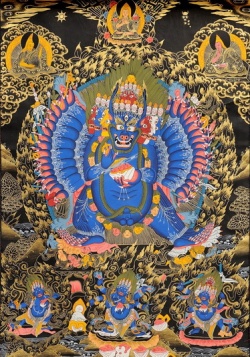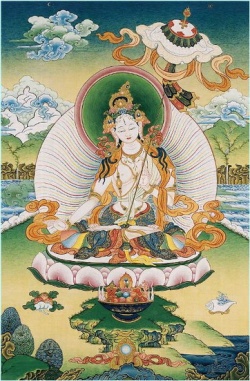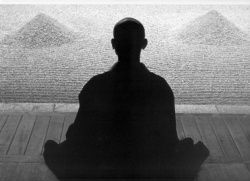Balkh and Rigden Concept
ASURA RIGDENS....."The Rigdens other than Rigden Raudrachakrin are of the Asura family because of bestowing fear.....Palden Raudrachakrin having a short spear bestows fear in the asura family.(Mipham)... "http://www.scribd.com/doc/99775539/Mipham-on-Kalachakra
In the Indian Buddhist tradition the Asura Gods are generally referred to as "Jealous Gods".....Trungpa once said that in the Shambhala tradition the Asura are referred to as "Feisty Gods".....
" The linguistic history indicates that the Aryans ("Indo-Europeans"..."Iran"....) originally formed a single people until the beginning of the 2nd millenium BC when the Deva worshipping Indian Aryans and the Asura worshiping Iranian Aryans went separate ways." (Yarshater: 1987..pg 684)...The Kalachakra discusses the expulsion of the Deva worshippers from Shambhala and refers to the Rigden kings as Asura...... " Rigden..."the eighth Rigden and subsequent Kings were called Kulika (rigs ldan) "one who bears the lineage". (Hopkins: 1985..pg 60)...
Kulika or Kalki Kings..."Since the Kalki has many queens, he has many sons and daughters. However, when the Kalki-to-be is born (it does not matter if he is the oldest son or not) there is a rain of white lotus flowers. The queen mother is a daughter of one of the 96 satraps of Shambhala. " (Newman ..1985)
The Mongolian term "Khalkha" (or Халх) has always puzzled linguists and historians. One possible interpretation is that it share the same root with the words "Халхавч" or "Shield" and "Халхлах" or to protect; to cover; to shield; to hide; to intercept; etc.
RIG....In Ancient Persia, the Indo-European words for King (Sanskrit: rajan...Latin: rex...Old Iranian: Rig...Gallic: rix)(Lincoln: 1981..pg 35)..means not only to regulate and direct in a manner that is right but also to shine with luster (Sk: raj). The divine right of the king was derived from the brilliance (cihr) and sovereignty (sahr) of the sky itself; therefore it was fitting that his palace should be in the 'padak' of the sun and that his 'tiara' should resemble the surrounding sky-wall and rays of the sun." ..(Campbell: 1968..pg 101)........
DEN...."In ancient Persia, 'Den' was the Old-Iranian term for wisdom. 'Den' operates as a creator within the limits of cyclic time and the motions of matter and space. 'Daena-Den' was an intermediate Creator between space and time. 'Den' reveals the Expanding (Spenta) and Good (Vohu) Mind (Mainyu) all that happens until the 'Fraskart' (The final restoration of the world)" ..(Campbell: 1968..pg 119+)
Kalkin (Tib: rigs ldan): chieftan, governor who holds the lineage, "one who bears the lineage"
The 7 Shakya Kings and the 25 Kulika Kings (Kalki)...
"Only 25 kings of Shambhala are specifically mentioned in the Wheel of Time Tantra and the names of their descendants are not given." (Kongtrul: 1995..pg 46)
"The country of Sambhala, protected by the 32 chieftans." (Kongtrul: 1995..pg 153)...
KALACHAKRA...(dus kyi khor lo)...Taught by the Buddha to Dawa Sangpo in South India in 881 BC (Dudjom:1991 pg 947)
"the 1047 verses of the Kalachakra Tantra used today (the original is 12,000 verses) was composed by the eighth King of Shambhala, the first Kulika (Kalki), Jampal Trakpa. The original 12,000 verses have never been translated into Tibetan." (Kongtrul: 1995..pg 271)..
"The Kalachakra is one of the last Sanskrit works to have been written in a Central Asian land." (Geoffrey Hopkins: 1985..pg 60)...
"King Sucandra wrote the 12,000 verse root text to the Kalachakra in an unknown tongue called the 'twilight language.' (sāṃdhyābhāṣā ...secret symbolic language)(Bryant: 1992..pg 68)...
"Sixteen translations of the Sri Kalachakra from Sanskrit to Tibetan appeared between the 11th and 14th centuries." (Bryant: 1992..pg 71)...
"Kalachakra taught at Dhanyakatanka, a huge, many leveled monument" (Hopkins: 1985..pg 59)....
"The lam yig's description of Sambhala is a curious melange of elements drawn from the canonical Indian Kalachakra literature (primarily the Vimalaprabha), erstwhile realia (the architecture, diet, and clothing of the Sambhalese), and the obligatory travellers sexology." (Newman in Cabezon:1996...pg 488)...
"The imperial rulers of Shambhala, who are called the Rigden Kings, are inhabitants of the cosmic mirror. They are referred to as ultimate drala. When you contact the wisdom of the cosmic mirror, you are meeting the ultimate dralas, the Rigden kings of Shambhala. Their vast vision lies behind all the activities of mankind, in the open, unconditioned space of mind itself. In that way, they watch over and protect human affairs, so to speak. This is quite different from the notion that the Rigdens are living on some celestial plane, from which they look down at the earth." (Trungpa: 1984..pg 174-175)...
"In Shambhala, the Kalki (the lineage king of Shambhala) and his queens possess the four aims of life: sensual pleasure, wealth, ethics, and liberation. They never become sick or old, and although they always enjoy sensual pleasure, their virtue never decreases. The Kalki does not have more than one or two heirs, but he has many daughters who are given as vajra ladies during the iniations held on the full moon of the Caitra each year....The houses in the villages of Shambhala are two storey houses. The people have find bodies and appearances and they are very wealthy. The men of Shambhala wear caps, and white or red cotton clothes. Women wear white or blue garments pleated and patterned with beautiful designs." (John R. Newman....1985)
This research explores my belief that historically, the 'legendary' Kingdom of Shambhala was located in the area of Shamis en Balkh (Sham-i-Bala, Bactra)....the great ancient city in Bactria (also known as Tagzig, Oddiyana, Olmo Lungring) and the great fertile region surrounded by the Pamir and Hindu Kush Mountains.


